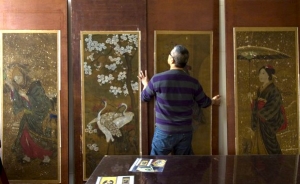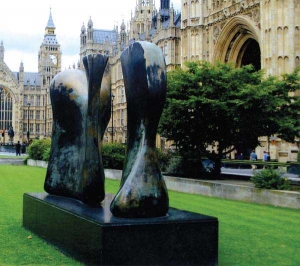|
Displaying items by tag: conservator
It was a heart-stopping moment when the conservator Alice Tate-Harte gently cleaned off centuries of thick black paint and grime and uncovered square Roman letters spelling out the name TITIANUS. The reputation of the bare-breasted young woman in the painting was instantly transformed: she has turned out to be a genuine work by one of the most revered masters of European painting, not a much later imitation of his style.
“It was a once-in-a-career moment, and there was nobody else in the conservation studio to share it – I had to ring my husband to have somebody to tell,” she recalled.
One of the most beloved paintings in the Gallery’s permanent collection, "Young Girl Reading" (c. 1770) by Jean-Honoré Fragonard, shows a young woman in profile, reading the book in her hand. It is now clear that a completely different face was painted underneath, that of an older woman looking out towards the viewer. Using groundbreaking imaging techniques and new art historical investigation, Yuriko Jackall, assistant curator of French paintings, John Delaney, senior imaging scientist, and Michael Swicklik, senior paintings conservator, all at the National Gallery of Art, recovered and reconstructed this first composition, a fully-realized, “lost” painting newly referred to as "Portrait of a Woman with a Book."
Morocco is due to get its first major national museum since gaining independence from France more than 50 years ago. The Mohammed VI Musée National d’Art Moderne et Contemporaine will open officially on 25 September. Located in the heart of the capital city Rabat, the three-level 22,350 sq. m building will consist of 4,921 sq. m for a permanent collection and 2,558 sq. m for temporary exhibits, conservation laboratories, an auditorium, education center, a multimedia library and a café. The ministry of culture and the Fonds Hassan II for Economic and Social Development funded the 73m Dh ($9m) building and Abdelazzi Idrissi, an archaeologist and conservator, has been appointed its director. The museum was scheduled to open at the end of May, although many thought the date somewhat optimistic.
Conceived in 1999 and under construction since 2004, the museum has been controversial.

The Museum of Modern Art announces the launch of Picasso: The Making of Cubism 1912–1914, the Museum’s first digital-only publication and the first monographic e-book to be authorized by the Estate of Pablo Picasso. Edited by Anne Umland, The Blanchette Hooker Rockefeller Curator of Painting and Sculpture, MoMA, and Blair Hartzell, independent art historian and curator, it embraces the innovative features and infinite real estate of the digital format in order to present new scholarship on a breakthrough moment in the history of Cubism and twentieth-century art. Scott Gerson, private art conservator and former Associate Conservator, MoMA, served as conservation editor on this cross-disciplinary project, which presents in-depth studies of 15 objects made by Picasso between 1912 and 1914. Contributing scholars include Elizabeth Cowling, Professor Emeritus and Honorary Fellow, History of Art, The University of Edinburgh; Jeremy Melius, Assistant Professor, Department of Art and Art History, Tufts University; and Jeffrey Weiss, Adjunct Professor, Institute of Fine Arts, New York University, and Senior Curator, Solomon R. Guggenheim Museum.
A painting that was “targeted for removal” from the collection of the Carnegie Museum of Art in Pittsburgh won a last-minute reprieve after a technical examination determined that it was not a “modern fake”, but a 16th-century Florentine portrait that was significantly “tarted up” in the 19th century.
“I was convinced it was a total modern fake,” says Lulu Lippincott, the institution’s curator of fine arts, referring to what was purportedly a portrait of Eleanor of Toledo by the Italian Mannerist Bronzino. “One look at the picture and I thought, ‘you’ve got to be kidding—this is not a Bronzino’,” she says. Convinced that the work was not the Old Master it claimed to be, Lippincott sent the picture to the conservation studio with a note asking Ellen Baxter, the museum’s chief conservator, to confirm that it was a fake.
The Delaware Art Museum in Wilmington is trying to track down a group of visitors who recently vandalized a number of the institution’s works with stickers. The stickers, which feature some religious script and imagery, were placed on a number of Pre-Raphaelite paintings and an outdoor statue. Other stickers with a large red “T” were also placed on the paintings.
The vandals were captured on the museum’s security cameras, but attempted to hide their identities. The stickers have been successfully removed by a painting conservator, but the amount of damage done to the collection is unknown. The Delaware Art Museum has one of the most celebrated collections of Pre-Raphaelite art outside of Britain.
In March, the Delaware Art Museum announced that it would deaccession four works from its collection to pay off its $19.8 million bond debt and replenish its endowment. The institution has not specified which works it plans to sell.

In the midst of its considerable expansion project, the Speed Art Museum in Louisville, Kentucky has been working with conservators to assess the condition of its collection and to oversee any necessary repairs. As part of this effort, the museum sent Paul Klee's "Seven Blossoms," an abstract watercolor and ink drawing on paper, to Nashville-based conservator, Christine Young, in hopes of halting discoloration to the already darkened work. Young was tasked with removing the acidic core of the paperboard that the drawing was mounted on, which was causing the discoloration. After carefully removing "Seven Blossoms" from its mount, Young discovered a previously unknown second drawing by Klee on the reverse.
Kim Spence, Curator of Prints, Drawings, and Photographs at the Speed Art Museum said, "Any discovery of a new work by an artist of Klee’s significance is exciting, but this discovery is particularly significant for the Speed. It expands our representation of the artist and illustrates different facets of his artistic production."
The drawing, which depicts a town or village with geometric buildings set against a faint landscape, will go on view at the museum's satellite space, Local Speed, on February 28, 2014. The work will be displayed in a double-sided frame so that both Klee compositions will be visible.

Six 140-year-old Japanese silk paintings by Utagawa Kunitsuru have undergone major restoration thanks to Washington, D.C.-based conservator, Yoshi Nishio. The paintings, which measure about 6 feet tall and 21 ½ feet wide, were previously hung in the Decatur House, a historic home and functioning museum, which serves as the National Center for White House History. The Decatur House is located across Lafayette Square from the White House and was designated a U.S. National Historic Landmark in 1976.
The paintings are believed to have been created in 1873 during a time of rich cultural exchange between Japan and the United States. The leading theory suggests that President Ulysses S. Grant acquired the works when he visited Japan in 1879 as part of a world tour. Only one of the six paintings is signed and dated.
The works have hung in the Decatur House for over a century and years of smoke, sunlight, and moisture had left the paintings wrinkled and darkened. Nishio, who received the paintings last year, spent hours cleaning the works with water, solvents, cotton swabs, and bamboo brushes with sable bristles. He worked on particularly delicate portions of the paintings with a scalpel under magnification. The paintings also had to be immersed in water to separate them from the boards they had been glued to.
The paintings, which feature a geisha, a robed samurai, white cranes, cherry blossoms, and a long-tailed rooster, are expected to return to the Decatur House in June 2013.

Henry Moore’s (1898-1986) severely damaged sculpture Knife Edge Two Piece (1965) will finally be restored according to the Parliamentary Art Collection. The sculpture, which is prominently displays outside of the Houses of Parliament in London, is England’s most revered work by the British sculptor.
Moore and the Contemporary Art Society donated Knife Edge Two Piece to England in 1967 but the work fell into disrepair after administrative changes left it with no legal owner. Eventually, the British government suggested that the House of Commons take ownership for the sculpture and that the Parliamentary Art Collection take responsibility for the its care.
The bronze sculpture, which is marred by discoloration, deterioration, and incised graffiti, will undergo conservation beginning February 16, 2013. Conservator Rupert Harris will lead the effort, which involves removing the sculpture’s protective lacquer and abrading its surface to eliminate the damage. The work will then be repatinated and treated with wax in order to protect it from future environmental damage.
The conservation project is expected to cost a little over $50,000 with most of the funding coming from the Parliamentary Art Collection. The Henry Moore Foundation will contribute about $17,000 to the effort. The Knife Edge Two Piece restoration project is expected to reach completion at the end of March 2013.

Domenico De Sole, chairman of the fashion powerhouse, Tom Ford International, is suing Michael Hammer, chairman of the disgraced Knoedler Gallery. De Sole and his wife, Eleanore, claim that Hammer sold the couple a fake Mark Rothko (1903–1970) painting (Untitled, 1956) for $8.3 million back in 2004. The allegation against Hammer is an amendment to a lawsuit that was originally filed against Knoedler on March 28.
De Sole’s suit is one of three against Knoedler and its former director, Ann Freedman. The suits all claim that Knoedler Gallery knowingly sold counterfeits. Between the three cases, the plaintiffs are seeking more than $70 million in damages.
Knoedler closed on November 30, 2011 after 165 years in the art world. A claim that the gallery sold a fake Jackson Pollack (1912–1956) painting for $17 million was the reason for Knoedler’s abrupt departure.
In addition to Hammer, the De Sole suit has introduced three new defendants to the ongoing Rothko/Knoedler case. Glafira Rosales, a Long Island art dealer who consigned artworks to Knoedler is newly involved as is as Jaime Andrade, a former Knoedler employee who introduced Rosales to the gallery. Jose Carlos Bergantinos Diaz, Rosales companion and business partner has also been added to the suit.
When Knoedler sold Untitled, 1956 to the De Soles, Freedman claimed that a Swiss collector had bought it directly from Rothko, and after the collector’s death, Knoedler was responsible for selling the work on his son’s behalf. The gallery had bought the painting from Rosales a year earlier for $950,000 and relied on her work about the painting’s provenance. Suspicions arose after Knoedler Gallery closed amidst the Pollack scandal and the De Soles’ lawyers hire a forensic conservator who found the painting’s marks and composition were inconsistent with Rothko’s technique.
|
|
|
|
|